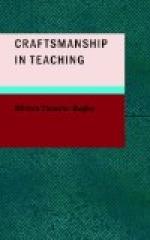I know of no way in which I can better introduce my subject than to describe very briefly the work of a superintendent who once furnished me with an example of a definite and effective method of supervision. This man was a “long range” superintendent. It was impossible for him to visit his schools very frequently, and so he did the next best thing: he had the schools brought to him. When I first saw him he was poring over a pile of papers that had just come in from one of his schools. I soon discovered that these papers were arranged in sets, each set being made up of samples taken each week from the work of the pupils in the schools under his supervision. The papers of each pupil were arranged in chronological order, and by looking through the set, he could note the growth that the pupil in question had made since the beginning of the term. Upon these papers, the superintendent recorded his judgment of the amount of improvement shown both in form and in content.
I was particularly impressed by the character of his criticisms. There was nothing vague or intangible about them. Every annotation was clear and definite. If penmanship happened to be the point at issue, he would note that the lines were too close together; that the letters did not have sufficient individuality; that the spaces between the words were not sufficiently wide; that the indentation was inadequate; that the writing was cramped, showing that the pen had not been held properly; that the margin needed correction. If the papers were defective from the standpoint of language, the criticisms were equally clear and definite. One pupil had misspelled the same word in three successive papers. “Be sure that this word appears in the next spelling list,” was the comment of the superintendent. Another pupil habitually used a bit of false syntax: “Place this upon the list of errors to be taken up and corrected.” Still others were uncertain about paragraphing: “Devote a language lesson to the paragraph before the next written exercise.” On the covers of each bundle of class papers, he wrote directions and suggestions of a more general nature; for example: “Improvement is not sufficiently marked; try for better results next time”; or: “I note that the pupils draw rather than write; look out for free movement.” Often, too, there were words of well-merited praise: “I like the way in which your pupils have responded to their drill. This is good. Keep it up.” And not infrequently suggestions were made as to content: “Tell this story in greater detail next time, and have it reproduced again”; or: “The form of these papers is good, but the nature study is poor; don’t sacrifice thought to form.”




